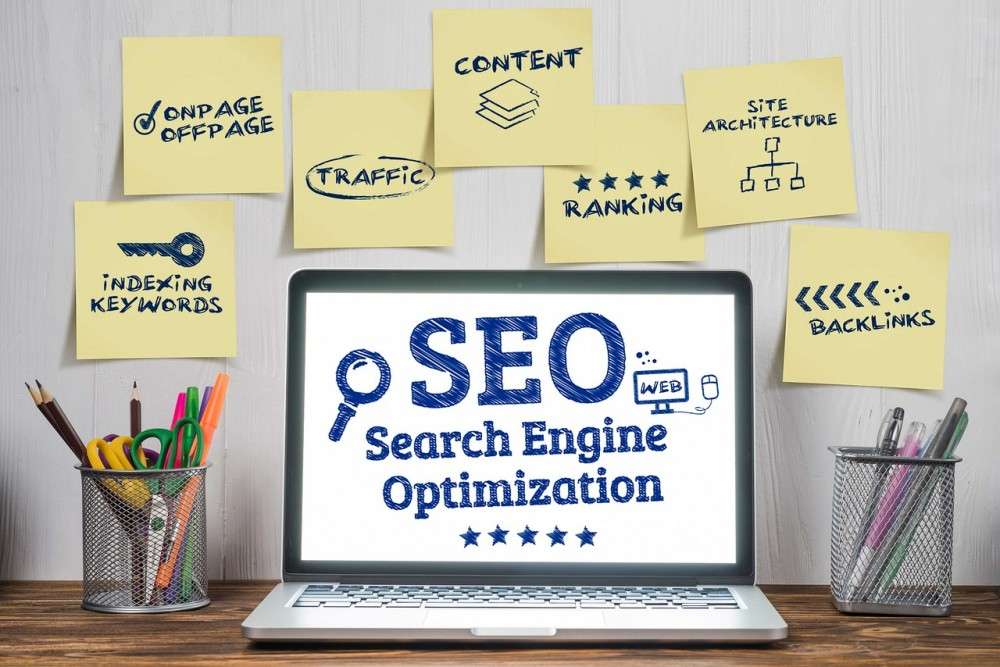In today’s digital age, where the internet is the first port of call for information and services, the significance of SEO (Search Engine Optimization) cannot be overstated. It’s the magic wand that can transform your online presence from being a needle in the haystack to a shining star on the search engine results page. In this comprehensive guide, we’ll delve deep into the world of SEO and unveil the secrets to boost your online visibility.
1 The Significance of SEO in the Digital Landscape
Picture this: the internet is an ever-expanding universe with billions of websites, each vying for the attention of the digital populace. In this vast expanse, SEO emerges as the guiding light, illuminating the path to online success. It’s the process of fine-tuning your website to align with the preferences of search engines like Google. The better you understand and implement SEO, the higher your website will rank, and the more likely you are to be discovered by eager searchers.
SEO isn’t just a passing trend; it’s a fundamental pillar of the digital age. Its significance lies in the fact that it offers a fair playing field for businesses and individuals to compete. Whether you’re a budding startup, an established enterprise, a blogger, or an e-commerce site owner, SEO provides an equal opportunity to shine.
Benefits of SEO in the Digital Landscape:
- Visibility: Higher rankings mean more visibility, leading to increased organic traffic.
- Credibility: Top search results are often seen as trustworthy sources, enhancing your brand’s credibility.
- Targeted Traffic: SEO helps you reach an audience actively searching for your products or content.
- Cost-Effective: Compared to paid advertising, SEO offers a cost-effective means of promotion.
This expansive guide isn’t just about scratching the surface of SEO; it’s about diving deep into its intricate workings. We’ll unravel the mysteries of SEO, providing you with both the knowledge and practical strategies to enhance your online presence.
2 Understanding the Basics of SEO
A. Definition of SEO
At its core, SEO is the art and science of optimizing your online presence to make it more attractive to search engines and users alike. It involves a myriad of techniques, both on and off your website, with the primary goal of improving your website’s ranking on search engine results pages (SERPs).
In simple terms, when someone types a query into a search engine, the goal of SEO is to ensure your website appears as close to the top of the results as possible. This isn’t about gaming the system; it’s about providing the best possible user experience and the most relevant content.
B. Why SEO is Essential for Online Businesses
For businesses operating in the digital realm, SEO is no longer a choice; it’s a necessity. Here’s why:
1. Enhanced Visibility: Consider this statistic – 75% of users never scroll past the first page of search results. If your website doesn’t appear on that coveted first page, it’s akin to setting up a shop in the middle of a deserted island. SEO can transport your business from the shadows to the spotlight.
2. Organic Traffic: Paid advertising can be costly, and it’s often perceived as less trustworthy by users. SEO brings organic, unpaid traffic to your website, allowing you to connect with a genuinely interested audience.
3. Competitive Advantage: If your competitors are investing in SEO, not doing so can put you at a significant disadvantage. SEO levels the playing field and ensures you’re not left behind.
4. Better User Experience: SEO isn’t just about search engines; it’s about creating a user-friendly website. This, in turn, enhances the overall user experience, which is crucial for retaining and converting visitors.
C. How Search Engines Work
To truly master SEO, you need to comprehend how search engines function. Search engines like Google use sophisticated algorithms to scan, index, and rank websites. Let’s break it down:
- Crawling: Search engines employ automated bots, often called “spiders” or “crawlers,” to scour the web. These bots follow links and index web pages, making them available for search.
- Indexing: Once a web page is crawled, it’s added to the search engine’s index, which is like a vast library of web pages. The index is where search engines store all the information they’ve collected.
- Ranking: When someone enters a search query, the search engine’s algorithm sifts through its index to find the most relevant results. The results are then ranked based on various factors, including keyword relevance, content quality, user experience, and backlinks.
Understanding these basics is crucial because it’s the foundation upon which you’ll build your SEO strategy. The better you align your website with how search engines work, the more likely you are to climb the ranks and enhance your online visibility.
Learn AGENCY SEO with our Expert Vetted Course
Acquire Agency SEO Digital Marketing knowledge with our Online Certification Course and take your business to the next level. Not only that, you can resell this course and gain 100% Profit Margin.
3 Keyword Research and Analysis
Keyword research is the cornerstone of SEO success. It’s the compass that guides you through the vast digital landscape, helping you discover what your audience is searching for and how to align your content with their needs. In this section, we’ll explore the art and science of keyword research.
A. The Foundation of SEO: Keywords
Keywords are the words or phrases people type into search engines to find information, products, or services. They are the connecting bridge between what your audience seeks and what your website offers. The foundation of SEO is built on understanding, selecting, and strategically using keywords.
The Power of Keywords:
- Relevance: Keywords ensure your content is relevant to user queries.
- Visibility: Well-chosen keywords can propel your content to the top of search results.
- User Intent: Keywords reveal what users are looking for, helping you tailor your content to their needs.
B. Tools and Techniques for Keyword Research
Keyword research is both an art and a science. Here’s how you can conduct effective keyword research:
1. Use Keyword Research Tools:
- Google Keyword Planner: A free tool by Google that provides keyword suggestions, search volume, and competition data.
- Ahrefs: Offers in-depth keyword research, competitor analysis, and content gap analysis.
- Semrush: Provides keyword analysis, competitor research, and trend tracking.
2. Understand User Intent:
- Consider what users intend to find when they search for a specific keyword. Are they looking for information, products, or local services? Tailor your content to match their intent.
3. Long-Tail Keywords:
- Long-tail keywords are longer, more specific phrases. They often have less competition and can be highly targeted. For example, “best running shoes for flat feet” is a long-tail keyword.
4. Competitive Analysis:
- Analyze your competitors’ content and the keywords they are targeting. Tools like Ahrefs and Semrush can help with this.
5. User-generated Keywords:
- Monitor user-generated content like reviews and comments on your website and social media. These can provide valuable insights into the words and phrases your audience uses.
C. Real-Life Scenario of Effective Keyword Selection
Let’s illustrate the power of keyword research with a real-life example. Imagine you run a blog about healthy eating, and you want to create a post about breakfast recipes. You start by using the Google Keyword Planner and find that the keyword “healthy breakfast recipes” has high search volume but also high competition. To stand out and attract a more specific audience, you decide to dig deeper.
Your research reveals that “low-calorie breakfast recipes” and “easy vegan breakfast ideas” are two long-tail keywords with substantial search volume and lower competition. These keywords align with what your audience is looking for and present an opportunity to rank higher in search results.
By choosing the right keywords, you’re not only optimizing your content for search engines but also ensuring that it resonates with the needs of your target audience. This strategic approach sets the stage for SEO success.
4 On-Page SEO Optimization
On-page SEO optimization is all about fine-tuning your website’s individual pages to make them search engine and user-friendly. It involves various techniques, from content creation to technical optimizations. Let’s explore the key elements of on-page SEO.
A. Crafting SEO-Friendly Content
Content is at the heart of SEO. Here’s how to craft content that’s not only user-friendly but also search engine-friendly:
- High-Quality Content: Content should be informative, engaging, and relevant to your target audience. It’s not just about keywords; it’s about providing value.
- Keyword Usage: Incorporate your target keywords naturally into your content. Don’t overdo it; focus on readability.
- Headings and Subheadings: Use headings (H1, H2, H3, etc.) to structure your content. This makes it easier for both users and search engines to understand your content’s hierarchy.
- Multimedia Elements: Include images, videos, and infographics to enhance user engagement. Optimize these elements for faster loading times.
- Internal and External Links: Link to other relevant pages on your website (internal linking) and to authoritative external sources. This enhances the user experience and SEO.
B. Optimizing Meta Tags and Headers
Meta tags and headers are the unsung heroes of SEO. They provide valuable information to search engines and users.
- Title Tags (Meta Title): Craft a unique and descriptive title for each page. Include your target keyword. This is what users see in search results.
- Meta Descriptions: Write compelling meta descriptions that summarize the page’s content. Make it enticing for users to click.
- Header Tags (H1, H2, H3, etc.): Use headers to structure your content. The H1 tag should contain the main topic, while H2 and H3 tags can be used for subtopics.
- URL Structure: Create clean and descriptive URLs that include keywords. Avoid lengthy, confusing URLs.
C. The Role of Internal Linking
Internal linking is the practice of linking to other pages within your website. It offers several benefits:
- Improved Navigation: Internal links help users navigate your website more easily, reducing bounce rates.
- Distributing Page Authority: Internal links can distribute the authority of high-ranking pages to others, enhancing their visibility.
- Enhancing User Experience: Relevant internal links guide users to related content, keeping them engaged.
- SEO Benefits: Internal links provide search engines with a better understanding of your website’s structure and content relationships.
D. The Importance of Mobile Optimization
In today’s mobile-centric world, optimizing your website for mobile devices is not a choice; it’s a necessity. Here’s why:
- Mobile-First Indexing: Google primarily uses the mobile version of the content for ranking and indexing. If your site isn’t mobile-friendly, it could impact your rankings.
- User Experience: Mobile users expect a seamless experience. A mobile-optimized site ensures faster loading times and better usability on small screens.
- Voice Search Compatibility: With the rise of voice search, mobile optimization becomes crucial. Voice search queries are often made on mobile devices.
- Responsive Design: Use responsive web design to ensure your site adapts to various screen sizes and devices.
Optimizing your website for mobile is no longer a trend; it’s a fundamental requirement to succeed in the digital landscape. Users on smartphones and tablets should enjoy the same level of accessibility and quality content as those on desktops.
5 Off-Page SEO Strategies
Off-page SEO is about activities outside your website that impact your search engine rankings. It’s all about building your website’s credibility and authority in the digital world. In this section, we’ll delve into essential off-page SEO strategies.

A. Building High-Quality Backlinks
Backlinks, also known as inbound links, are links from other websites to yours. They serve as a vote of confidence in your content. However, not all backlinks are created equal. High-quality backlinks from authoritative and relevant websites carry more weight in the eyes of search engines.
How to Build High-Quality Backlinks:
- Guest Posting: Write guest posts for reputable websites in your niche. Include a link back to your site in your author bio or within the content (if relevant).
- Content Marketing: Create exceptional content that naturally attracts backlinks. Infographics, research reports, and in-depth guides often earn links.
- Outreach: Reach out to website owners and bloggers in your niche. Offer them valuable content in exchange for a backlink.
- Social Sharing: Promote your content on social media. Viral content often garners organic backlinks.
- Broken Link Building: Find broken links on other websites and offer your content as a replacement.
- Monitor Mentions: Use tools to monitor when your brand or content is mentioned but not linked. Politely ask for a link in such cases.
B. Social Media and Its Impact on SEO
Social media and SEO are like two peas in a pod. While social signals (likes, shares, comments) are not direct ranking factors, they can indirectly influence your SEO in several ways:
- Content Promotion: Sharing your content on social media can increase its visibility, leading to more potential backlinks and traffic.
- Brand Authority: A strong social media presence can enhance your brand’s authority, which can indirectly influence search engine rankings.
- Local SEO: Social media profiles are often part of local search results, particularly for small businesses. Consistent profiles with accurate information can improve local SEO.
- User Engagement: Engaging with your audience on social media can lead to a more loyal following and increased user-generated content, both of which are beneficial for SEO.
- Social Profiles in Search Results: Social profiles for businesses and individuals can appear in search results. Optimize your profiles for better visibility.
C. Guest Posting and Its Benefits
Guest posting is a strategic off-page SEO technique where you contribute content to other websites or blogs in your niche. This technique offers several advantages:
1. Backlinks: In your guest posts, you can often include backlinks to your own website, providing a valuable link-building opportunity.
2. Audience Expansion: Guest posting allows you to reach a broader audience that may not have discovered your website otherwise.
3. Authority Building: By contributing high-quality content to authoritative websites, you build your own credibility and authority in your niche.
4. Networking: Guest posting fosters relationships with other bloggers and website owners, potentially leading to more collaboration and opportunities.
5. Brand Exposure: Guest posts can help expose your brand to a new set of readers, increasing brand recognition.
Remember that effective guest posting is about quality, not quantity. Focus on providing valuable content to the audience of the host website, and the SEO benefits will follow naturally.
6 Technical SEO: Enhancing Website Performance
Technical SEO deals with the behind-the-scenes elements that ensure your website is crawlable, indexable, and provides a smooth user experience. Let’s explore the technical aspects that can enhance your website’s performance.
A. Site Speed and Its Influence on SEO
Website speed is a critical factor for both user experience and SEO. A slow-loading website can drive visitors away and adversely affect your search engine rankings.
How Site Speed Impacts SEO:
- Rankings: Google considers page speed as a ranking factor. Faster sites tend to rank higher.
- User Experience: Slow websites frustrate users, leading to higher bounce rates and lower dwell time, both of which can impact rankings.
- Mobile Optimization: Mobile users, in particular, demand fast-loading pages.
Tips for Improving Site Speed:
- Optimize Images: Compress and resize images to reduce load times.
- Minimize HTTP Requests: Reduce the number of elements on your pages, such as scripts and stylesheets.
- Browser Caching: Enable browser caching to store elements locally on a user’s device, reducing the need to download them repeatedly.
- Content Delivery Network (CDN): Use a CDN to distribute content across multiple servers, reducing server response times.
- Mobile Optimization: Prioritize mobile performance, as it’s crucial for SEO.
B. XML Sitemaps and robots.txt
XML sitemaps and robots.txt files are like road signs for search engines, guiding them on how to crawl and index your site.
XML Sitemaps:
- An XML sitemap is a list of all the pages on your website that you want search engines to index.
- It helps search engines discover and prioritize your content.
- Include XML sitemaps in your Google Search Console account for better indexing control.
Robots.txt:
- The robots.txt file tells search engines which parts of your site they can or cannot crawl.
- Use it to block search engines from indexing non-essential or duplicate content.
- Be careful when configuring robots.txt to avoid accidental blocking of important pages.
C. Schema Markup for Rich Snippets
Schema markup, also known as structured data, is a form of metadata that you can add to your website’s HTML. It provides additional information to search engines, which can be displayed as rich snippets in search results.
Benefits of Schema Markup:
- Enhanced Visibility: Rich snippets make your search results more eye-catching, potentially increasing click-through rates.
- Content Relevance: Schema markup helps search engines understand the content of your pages better.
- Specific Information: It allows you to highlight specific details like ratings, prices, and event dates.
Implementing schema markup requires adding code to your web pages. You can use Google’s Structured Data Markup Helper to generate code for various types of structured data, such as articles, events, products, and more.
By enhancing your website’s technical aspects, you not only provide a better experience for users but also make it more search engine-friendly. These technical SEO optimizations pave the way for improved rankings and increased online visibility.
Learn AGENCY SEO with our Expert Vetted Course
Acquire Agency SEO Digital Marketing knowledge with our Online Certification Course and take your business to the next level. Not only that, you can resell this course and gain 100% Profit Margin.
7 Content Marketing and SEO
Content marketing and SEO go hand in hand, creating a powerful synergy that can propel your online visibility to new heights. In this section, we’ll explore how to create engaging content, the intricate relationship between content and SEO, and the utilization of user-generated content.
A. Creating Engaging and Shareable Content
Engaging and shareable content is the heart and soul of content marketing. It not only attracts users but also entices them to share your content with others, amplifying your online presence.
Creating Engaging Content:
- Know Your Audience: Understand your target audience’s interests, pain points, and preferences.
- Valuable Information: Offer valuable, informative, and actionable content that solves problems or fulfills needs.
- Visual Appeal: Incorporate visuals, such as images, infographics, and videos, to enhance engagement.
- Storytelling: Weave compelling narratives into your content to connect with readers on an emotional level.
- Interactivity: Include elements like quizzes, surveys, and interactive tools to engage users.
Making Content Shareable:
- Social Sharing Buttons: Make it easy for users to share your content on social media by including share buttons.
- Inspirational Content: Content that inspires, educates, or entertains is more likely to be shared.
- Encourage User-Generated Content: Encourage users to share their experiences with your brand or content.
B. The Relationship Between Content and SEO
The relationship between content and SEO is symbiotic. Content provides the substance, while SEO ensures it’s discovered and appreciated.
Keywords and Content:
- Use relevant keywords naturally within your content to signal its topic to search engines.
- Keyword optimization includes using keywords in titles, headings, and throughout the content.
- Avoid keyword stuffing, as it can harm user experience and SEO.
Quality and Relevance:
- Search engines prioritize high-quality, relevant content.
- Content must fulfill the user’s search intent to rank well.
- Content freshness is also considered by search engines.
User Experience:
- Content that provides a positive user experience is favored by search engines.
- Factors like mobile optimization, fast load times, and easy navigation are crucial.
Backlinks and Content:
- High-quality content attracts backlinks, which are vital for SEO.
- Backlinks from authoritative sites signal your content’s value to search engines.
C. Utilizing User-Generated Content
User-generated content is a goldmine for content marketing and SEO. It’s content created by your audience, such as reviews, comments, and social media posts. Leveraging this content can be highly beneficial.
Benefits of User-Generated Content:
- Social Proof: User-generated content serves as social proof, building trust in your brand.
- Unique Perspectives: User content often provides unique perspectives and experiences that can resonate with others.
- SEO Impact: Reviews and discussions contribute to fresh, relevant content that can boost SEO.
- Engagement: Engaging with user-generated content enhances the sense of community around your brand.
To encourage user-generated content, interact with your audience on social media, host contests or challenges, and feature user content on your website. Always ask for permission and give proper credit when using user-generated content.
8 Local SEO for Small Businesses
Local SEO is a game-changer for small businesses, as it helps them compete effectively in their local markets. In this section, we’ll explore the importance of local SEO, optimizing your Google My Business listing, and the significance of NAP consistency and local citations.
A. The Importance of Local SEO
Local SEO is all about optimizing your online presence for local searches. For small businesses, this is crucial because it connects you with nearby customers actively seeking your products or services.
Why Local SEO Matters:
- Local Intent: Many online searches have local intent, with users looking for “near me” or location-specific results.
- Competitive Advantage: Local SEO helps small businesses compete with larger, national brands.
- Mobile-Friendly: Mobile users often seek local information, making mobile optimization essential for local SEO.
- Customer Trust: High-ranking local results are seen as trustworthy sources by users.
B. Google My Business Optimization
Google My Business (GMB) is a cornerstone of local SEO. It’s your business profile on Google, and optimizing it is vital for local visibility.
Tips for GMB Optimization:
- Accurate Information: Ensure all details, such as your business name, address, phone number, and website, are accurate and consistent with your online presence.
- Category Selection: Choose relevant categories that describe your business accurately.
- Photos and Videos: Add high-quality photos and videos showcasing your products or services.
- Customer Reviews: Encourage and respond to customer reviews on your GMB listing.
- Business Hours: Keep your operating hours up to date.
- Posts and Updates: Regularly post updates, special offers, and events on your GMB listing.
C. NAP Consistency and Local Citations
NAP stands for Name, Address, and Phone Number. Consistency in NAP information across the web is critical for local SEO.
NAP Consistency:
- Ensure your NAP information is consistent on your website, GMB listing, and all online directories.
- Inconsistent information can confuse both users and search engines, leading to lower local rankings.
Local Citations:
- Citations are online references to your business’s NAP information.
- Build local citations by listing your business in online directories, review sites, and local business associations.
- Citations help validate your business’s authenticity and improve local SEO.
Mastering local SEO empowers small businesses to capture nearby customers and compete effectively in their local markets. It’s a potent tool for enhancing online visibility and growing a loyal customer base.
9 SEO Analytics and Tracking
Understanding the performance of your SEO efforts is essential for ongoing improvement. In this section, we’ll explore the tools for SEO analytics and tracking, the significance of key performance indicators (KPIs), and a real-life case study illustrating the process of tracking SEO progress.

A. Using Google Analytics and Search Console
Google Analytics and Google Search Console are invaluable tools for monitoring your website’s performance and SEO efforts.
Google Analytics provides in-depth insights into your website’s traffic, user behavior, and conversions. You can track:
- Traffic Sources: Discover how users find your site, whether through organic search, referrals, or social media.
- User Behavior: Understand how users interact with your site, including page views, bounce rate, and time on site.
- Conversion Tracking: Measure the success of specific goals, such as form submissions or e-commerce transactions.
Google Search Console is tailored for SEO and offers insights into how Google perceives your site. You can:
- Monitor Indexing: Ensure Google has indexed your site’s pages correctly and identify indexing issues.
- Keyword Performance: See which keywords are driving traffic to your site and monitor click-through rates.
- Fix Crawl Errors: Address issues like broken links and crawl errors to improve search engine accessibility.
B. Measuring SEO Success with KPIs
Key Performance Indicators (KPIs) are essential for quantifying the success of your SEO efforts. Here are some critical KPIs to track:
- Organic Traffic: Measure the number of visitors coming to your site from search engines.
- Keyword Rankings: Track the ranking positions of your target keywords over time.
- Click-Through Rate (CTR): Monitor the percentage of users who click on your search results.
- Conversion Rate: Measure the rate at which visitors complete desired actions, such as making a purchase or filling out a contact form.
- Bounce Rate: Assess the percentage of visitors who leave your site without engaging with it.
- Backlink Quality and Quantity: Keep an eye on the number and quality of backlinks to your site.
- Page Load Speed: Slow-loading pages can lead to a poor user experience and lower rankings.
Setting and tracking KPIs provides clarity on what’s working and where improvements are needed in your SEO strategy.
C. Real-Life Case Study on Tracking SEO Progress
Let’s dive into a real-life case study to see how tracking SEO progress can impact a website’s performance.
Case Study: The E-Commerce Boost
Background: An online clothing store, “Style X,” wanted to boost its online presence and sales. They invested in a comprehensive SEO strategy.
Key Steps and Progress:
- Keyword Research: Style X identified relevant keywords for their products, such as “women’s summer dresses” and “men’s athletic shoes.”
- Content Optimization: They optimized product descriptions, meta tags, and images for SEO, ensuring each page targeted specific keywords.
- Backlink Building: Style X engaged in a backlink-building campaign, earning links from fashion blogs and industry influencers.
- Social Media Integration: They incorporated social sharing buttons on their product pages to encourage users to share their favorite items.
Results:
- Organic Traffic: Over six months, organic traffic increased by 40%, resulting in more potential customers browsing the site.
- Keyword Rankings: The website saw a steady rise in rankings for target keywords, with several reaching the top 10 positions.
- Click-Through Rate: Optimized meta tags and compelling product descriptions boosted click-through rates.
- Conversion Rate: A/B testing on product pages led to a 15% increase in conversion rates.
- Backlink Quality: Style X secured high-quality backlinks from fashion magazines and influencers, further boosting their authority.
This case study illustrates how meticulous tracking of SEO progress, along with the right strategies, can significantly impact a website’s performance, leading to increased traffic, better rankings, and ultimately, higher revenue.
10 SEO Trends and Future Predictions
The world of SEO is continually evolving. In this section, we’ll explore current SEO trends, including the impact of voice search, the rise of video SEO, and how to prepare for upcoming SEO changes.
A. Voice Search and Its Impact on SEO
Voice search is becoming increasingly prevalent with the rise of virtual assistants like Siri, Alexa, and Google Assistant. Here’s how it impacts SEO:
- Conversational Queries: Voice search often involves more natural, conversational queries. Optimize your content for long-tail and question-based keywords.
- Local Optimization: Many voice searches are location-based. Ensure your local SEO is robust.
- Featured Snippets: Voice assistants often read out featured snippets. Focus on ranking for these.
Prepare for Voice Search:
- Optimize for Featured Snippets: Position your content to appear as a featured snippet.
- Local SEO: Make sure your business information is accurate on Google My Business.
- Conversational Content: Create content that answers common voice search questions.
B. The Rise of Video SEO
Video is a dynamic and engaging medium, and search engines are recognizing its value.
- Video SEO: Optimize video titles, descriptions, and tags with relevant keywords.
- YouTube: As the second-largest search engine, YouTube offers a significant SEO opportunity. Create and optimize your YouTube channel.
Tips for Video SEO:
- Quality Content: Create high-quality, engaging videos that resonate with your target audience.
- Optimize Thumbnails: Thumbnails should be eye-catching and relevant to the video’s content.
- Engage Viewers: Encourage likes, shares, and comments to boost engagement.
C. Preparing for Upcoming SEO Changes
Search engines continually update their algorithms. To prepare for future SEO changes:
- Mobile-First Indexing: Ensure your website is mobile-friendly, as mobile-first indexing is a growing trend.
- User Experience: Focus on providing an exceptional user experience, as search engines prioritize this.
- Structured Data: Implement structured data (schema markup) for enhanced search results.
- Content Quality: Continue to produce high-quality, relevant content.
Staying informed about industry developments and being adaptable in your SEO strategy is key to future success.
11 Common SEO Mistakes to Avoid
In our journey through the world of SEO, it’s crucial to be aware of common pitfalls and mistakes that can hinder your progress. In this section, we’ll explore the pitfalls of over-optimization, the dangers of black hat SEO, and the significance of not ignoring the user experience.
A. Over-Optimization Pitfalls
Over-optimization, or “stuffing” your content with too many keywords, can have adverse effects on your SEO strategy.
Common Over-Optimization Mistakes:
- Keyword Stuffing: Repeating the same keyword excessively in your content.
- Irrelevant Keywords: Using keywords that don’t naturally fit into your content.
- Ignoring User Experience: Prioritizing search engines over the needs of your audience.
Impact of Over-Optimization:
- Google penalizes over-optimized content, causing lower rankings.
- User experience suffers as content becomes less readable and engaging.
Avoiding Over-Optimization:
- Focus on high-quality, valuable content.
- Use keywords naturally and avoid excessive repetition.
- Prioritize user experience.
B. The Dangers of Black Hat SEO
Black hat SEO techniques violate search engine guidelines and can lead to severe penalties.
Common Black Hat SEO Practices:
- Keyword Stuffing: Excessive use of keywords.
- Cloaking: Showing different content to search engines and users.
- Link Schemes: Manipulating links for rankings.
- Content Scraping: Copying content from other websites.
Impact of Black Hat SEO:
- Immediate results may be seen, but long-term risks are high.
- Google can penalize your site, leading to a significant drop in rankings.
Choosing Ethical SEO:
- Stick to white hat SEO techniques that follow search engine guidelines.
- Focus on creating valuable content and building natural backlinks.
C. Ignoring the User Experience
A common SEO mistake is prioritizing search engine rankings at the expense of user experience.
User Experience Matters:
- A poor user experience can lead to high bounce rates.
- Slow-loading pages, intrusive ads, and confusing navigation frustrate users.
Balancing SEO and User Experience:
- Prioritize content that’s informative and engaging.
- Optimize for mobile devices.
- Create an intuitive website structure.
Remember, SEO is about providing value to both search engines and users. A seamless user experience can positively impact your rankings.
12 SEO Tools and Resources
A. A Comprehensive List of SEO Tools
SEO tools are invaluable for your journey to improve online visibility. Here’s a list of some essential SEO tools:
| Tool | Purpose |
|---|---|
| Google Analytics | Web traffic analysis |
| Google Search Console | Site performance data |
| SEMrush | Keyword research and competitive analysis |
| Ahrefs | Backlink analysis and SEO research |
| Moz | SEO analytics and research |
| Yoast SEO (WordPress plugin) | On-page SEO optimization |
| Screaming Frog | Website crawling and technical SEO analysis |
| Google Keyword Planner | Keyword research |
| Ubersuggest | Keyword and content ideas |
| GTmetrix | Site speed analysis |
| Google PageSpeed Insights | Site speed optimization |
B. Online Communities and Forums for SEO Enthusiasts
Connect with the SEO community to stay updated and learn from experts. Here are some online forums and communities:
- Moz Community: Moz’s Q&A forum is a great place to seek answers to your SEO questions and connect with professionals.
- Warrior Forum: A community where digital marketers discuss SEO strategies and other online marketing topics.
- Reddit SEO: The SEO subreddit is a valuable resource for discussions and sharing knowledge.
- Webmaster World: This forum covers a wide range of internet marketing topics, including SEO.
- LinkedIn Groups: Join SEO-related LinkedIn groups to network with professionals and learn about industry trends.
Learn AGENCY SEO with our Expert Vetted Course
Acquire Agency SEO Digital Marketing knowledge with our Online Certification Course and take your business to the next level. Not only that, you can resell this course and gain 100% Profit Margin.
Looking for more Online Certification Courses? Then you may check here for all our Courses.
Conclusion
SEO is a dynamic field that constantly evolves. What works today may not work tomorrow. As search engines like Google continue to update their algorithms, staying current with best practices and embracing change is vital for online success.
Mastering SEO is a journey, not a destination. It’s a continuous process of learning, adapting, and refining your strategies. Embrace the journey, and you’ll see the rewards in the form of increased online visibility, more traffic, and business growth.
In a digital world teeming with competition, mastering SEO is the key to boosting your online visibility. It’s a multifaceted discipline that combines technical expertise, content creation, and user-centric strategies. As you navigate the SEO landscape, remember that the user experience is paramount. Engage your audience with quality, shareable content, avoid common SEO pitfalls, and leverage the power of ethical SEO techniques.













